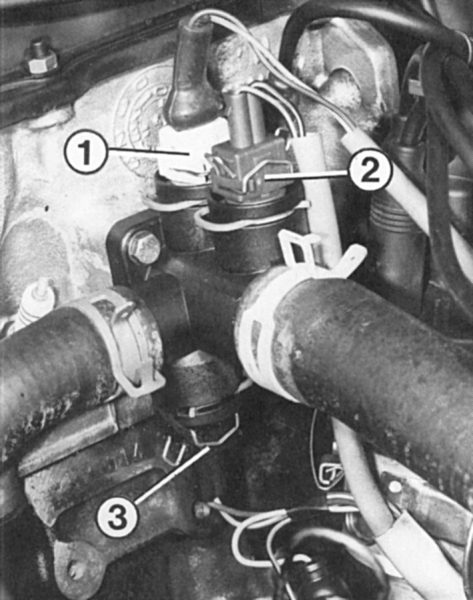
P0115 Engine Coolant Temperature Sensor Circuit Malfunction
Content
Trouble Code P0115 OBD-II Datasheet
Engine Coolant Sensor (ECT) Circuit Malfunction
What does this mean?
This Diagnostic Trouble Code (DTC) is considered generic as it applies to all 1996 OBD-II equipped vehicles. Specific troubleshooting and repair steps may vary slightly depending on the brand / model.
The ECT (Engine Coolant Temperature) sensor is a thermistor whose resistance changes with temperature. Typically this is a 5-wire sensor, a 0115V reference signal from the PCM (Powertrain Control Module) and a ground signal to the PCM. This is different from the TEMPERATURE SENSOR (which usually controls the dashboard temperature sensor and works the same as the SENSOR, only it is a different circuit than the one that PXNUMX applies to).
When the coolant temperature changes, the ground resistance changes at the PCM. When the engine is cold, the resistance is great. When the engine is warm, the resistance is low. If the PCM detects a voltage condition that appears to be abnormally low or high, P0115 install.
 Example of an ECT engine coolant temperature sensor
Example of an ECT engine coolant temperature sensor
Symptoms of error P0115
Symptoms of a P0115 trouble code may include:
- The ECM turns on the Check Engine light and goes into failsafe mode, ignoring input at 176 degrees Fahrenheit.
- The engine may not start well when it is cold and start normally when it is warm.
- The engine may run rough and oscillate until the engine warms up
- The engine should run close to normal once the engine has warmed up.
- MIL (Malfunction Indicator Lamp) Always On
- The car may be difficult to start
- Can blow out a lot of black smoke and become very rich
- The engine may stall or the exhaust pipe may catch fire.
- The engine may run on a lean mixture and may experience increased NOx emissions (gas analyzer required)
- Cooling fans can run continuously when they shouldn't be running, or not when they should be running at all.
Causes
The ECT sensor range applied to the ECM has risen to -40°F or above 284°F, indicating a short or open circuit.
Codes P0117 or P0118 for a short or open circuit usually accompany code P0115.
Usually the cause can be attributed to a faulty ECT sensor, however, this does not exclude the following:
- Damaged wiring or connector on the sensor
- Open or short circuit in the reference or signal circuit
- Open or short circuit in the signal circuit
- Bad PCM
Possible solutions
First, visually inspect the sensor for damage to the wiring or connector and repair if necessary. Then, if you have access to a scanner, determine what the engine temperature is. (If you don't have access to a scan tool, using a temperature sensor on the dashboard can be an ineffective way of detecting the coolant temperature. This is because the P0115 code refers to an ECT SENSOR and the dashboard is controlled, usually a single wire SENDER. Basically it is another sensor to which the code does not apply.)
2. If the engine temperature is excessively high, about 280 degrees. F, this is not normal. Disconnect the sensor on the engine and see if the signal drops to, say, minus 50 degrees. F. If so, you can bet the sensor is faulty, shorted internally, causing a low resistance signal to be sent to the PCM. However, if you want to make sure that it is the sensor and not the wiring, you can do a couple of tests. With the ECT sensor disabled, make sure you have 5 volts in the reference circuit with KOEO (engine off key). You can also check the resistance of the sensor to ground with an ohmmeter. The resistance of the normal sensor to ground will differ slightly depending on the vehicle, but mostly if the engine temperature is around 200 degrees. F., the resistance will be about 200 ohms. If the temperature is around 0 def. F., the resistance will be over 10,000 ohms. With this test, you will be able to determine if the sensor resistance matches the engine temperature. If it doesn't match your engine temperature, then you probably have a faulty sensor.
3. Now, if the engine temperature according to the scanner is about 280 degrees. F. and disconnecting the sensor does not lead to a drop in the reading to negative 50 degrees. F, but it stays at the same high temperature reading, then you need to clear the signal circuit (ground) short to the PCM. It is shorted somewhere directly to ground.
4. If the readings of the engine temperature on the scanner show negative 50 degrees. Something like this (and you do not live in the Arctic!) Disconnect the sensor and check for a 5V reference voltage on the sensor.
5. If not, check the PCM connector for proper 5V reference. If present on the PCM connector, repair the open or short circuit in the 5V reference from the PCM. If there is no 5V reference voltage on the PCM connector, then you have completed the diagnosis and the PCM may be faulty. 6. If the 5V reference circuit is intact, test the ground signal at the PCM using the previous ground resistance test. If the resistance does not match the engine temperature, reduce the resistance of the ground signal to the PCM by disconnecting the ground signal wire from the PCM connector. The wire must be free of resistance, disconnected from the PCM to the sensor. If so, repair the gap in the signal to the PCM. If it has no resistance on the signal ground wire and the sensor resistance test is normal, then suspect a faulty PCM.
Other engine coolant indicator codes: P0115, P0116, P0117, P0118, P0119, P0125, P0128
HOW DOES A MECHANIC DIAGNOSTIC CODE P0115?
- Scans and documents received codes and displays freeze frame data to see when a code was set
- It resets codes to clear OBD-II trouble codes and retests the car to see if the code returns.
If codes P0117 or P0118 are received, mechanics will first run tests for these codes.
COMMON ERRORS WHEN DIAGNOSING CODE P0115
- Do not make a preliminary visual inspection
- No testing codes P0117 or P0118
- Do not replace ECT sensor unless tests indicate a problem
- Do not connect a new ECT sensor and review the ECM data to ensure the sensor output temperature is close to ambient temperature before installation.
HOW SERIOUS CODE P0115 IS?
- Code P0115 will cause the engine ECM to go into fail safe mode.
- Safe Mode can cause various driving problems until the engine warms up, depending on the manufacturer's Safe Mode strategy.
WHAT REPAIRS CAN FIX CODE P0115?
- Repair or replace ECT connector
- Repair or replace wiring as needed
- Replace the ECT with a new sensor.
ADDITIONAL COMMENTS TO BE AWARE OF CODE P0115
- Code P0115 is often associated with codes P0116, P0117, P0118 and P0119.
- Most errors for code P0115 are related to a shorted wiring or corroded connector causing an open circuit.
Need more help with your p0115 code?
If you still need help with DTC P0115, post a question in the comments below this article.
NOTE. This information is provided for informational purposes only. It is not intended to be used as a repair recommendation and we are not responsible for any action you take on any vehicle. All information on this site is protected by copyright.

One comment
Manuel Sanchez Benitez
MY KIA CARNIVAL 29CRDI FROM YEAR 2004 HAS GOT A LITTLE HEAT OF THE STOP AND IT HAS NOT STARTED AGAIN AND IT ALWAYS HAS THE PERMANENT FAULT CODE P0115 IT IS IMPOSSIBLE TO ERASE I HAVE PUT A NEW SENSOR ON IT AND IT IS STILL THE SAME I HAVE CHECKED AND IT HAS 5V, BUT NO IT STARTED AND THERE IS NO WAY TO DELETE THIS CODE, I WOULD APPRECIATE ANY HELP, THANKS